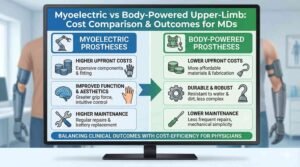
Myoelectric vs Body-Powered Upper-Limb: Cost Comparison & Outcomes for MDs
For doctors treating upper-limb loss, the choice between a myoelectric prosthesis and a body-powered device
Buy Products, Consumables and Accessories from Robo Bionics Dismiss
Skip to content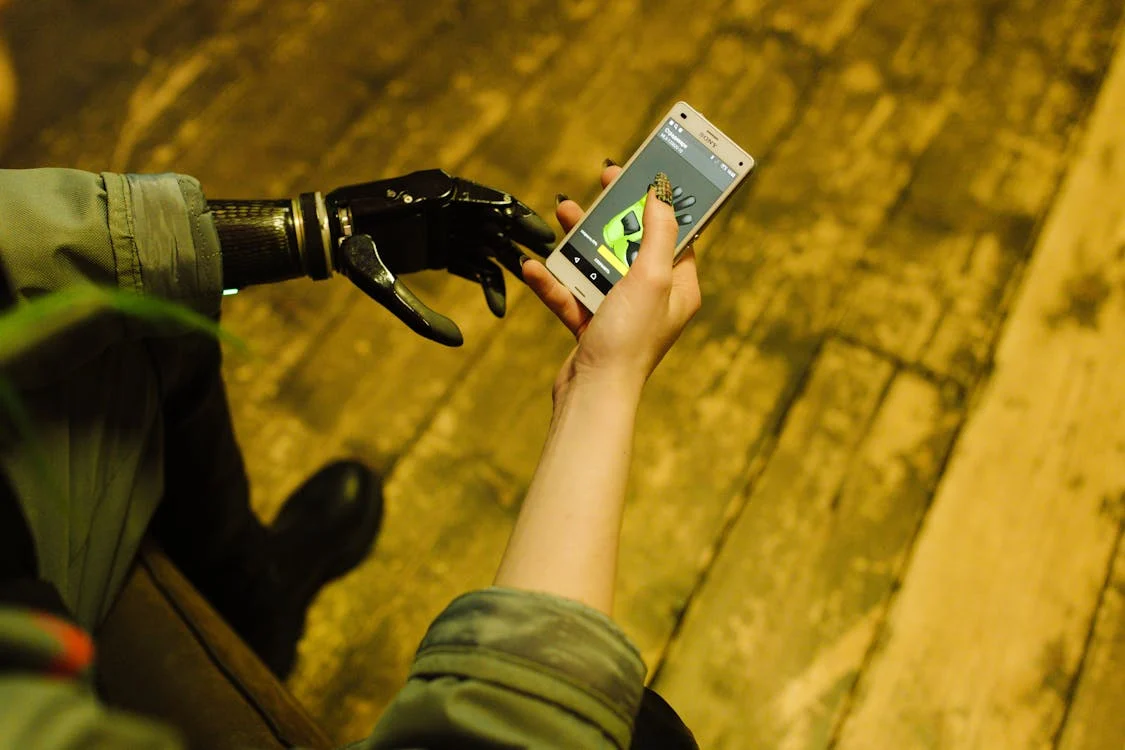
A prosthetic device is more than just a piece of technology; it’s an integral part of your daily life. It supports your mobility, independence, and confidence, helping you engage with the world on your terms. But like any tool that’s used regularly, a prosthetic requires proper care and attention to remain comfortable and functional over time.
The journey to long-term comfort and performance isn’t just about fixing problems as they arise—it’s about adopting proactive strategies that ensure your prosthetic adapts to your body, lifestyle, and environment. In this guide, we’ll explore actionable steps to help you maintain your prosthetic, addressing both its physical components and the connection it has with your body.
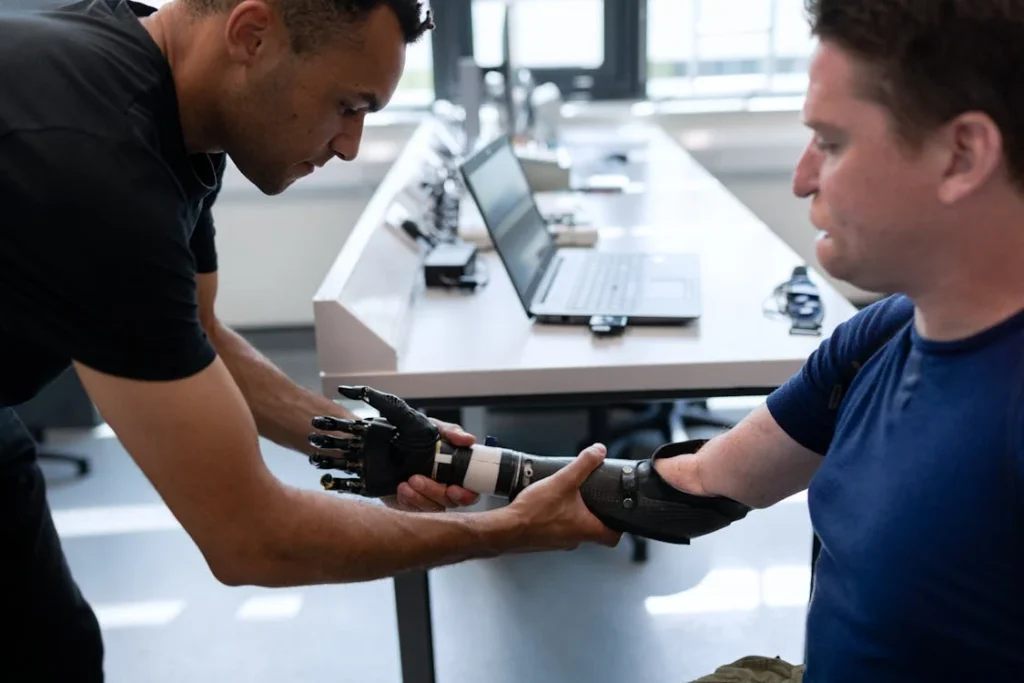
Achieving and maintaining long-term comfort with a prosthetic is not an isolated task—it’s an evolving process that requires attention to your body’s needs, the environment, and the functionality of the device.
Comfort stems from a combination of factors, including proper fit, consistent care, and seamless integration into your lifestyle. By taking a strategic approach, you can ensure your prosthetic remains a dependable and comfortable companion for years to come.
The fit of a prosthetic is the cornerstone of comfort, but it is not a fixed attribute. Over time, changes in your residual limb can impact the way your prosthetic feels.
Swelling, muscle atrophy, weight fluctuations, and even daily activities can subtly alter the interaction between your limb and the socket. Maintaining comfort requires adapting to these changes as they occur.
One key to this balance is consistent monitoring. Pay attention to how your prosthetic feels during different times of the day and after specific activities.
This awareness allows you to recognize early signs of discomfort and make necessary adjustments, such as modifying the fit with prosthetic socks or consulting your prosthetist for more extensive realignments.
Alignment is a critical factor that directly impacts how your prosthetic distributes weight, supports your movements, and interacts with your residual limb. Even a slight misalignment can cause uneven pressure, leading to discomfort, irritation, or strain on other parts of your body.
Proper alignment ensures that your prosthetic supports your natural gait and posture, reducing the risk of secondary issues such as joint pain or muscular fatigue.
Regular professional evaluations are essential to maintaining this alignment over time, particularly if you notice any changes in how your prosthetic feels or performs during movement.
Comfort and functionality are deeply interconnected. A prosthetic that doesn’t feel comfortable may discourage you from using it as intended, limiting its effectiveness and hindering your ability to engage fully in daily activities.
Conversely, a comfortable prosthetic enhances your confidence, enabling you to move naturally and perform tasks with ease.
This connection highlights the importance of addressing even minor discomforts promptly. Small irritations, if ignored, can grow into significant challenges that impact both your physical and emotional well-being.
Viewing comfort as a foundation for functionality ensures you stay proactive in maintaining your device.
Modern prosthetics leverage advanced technology to improve comfort in ways that were previously unimaginable.
Features like microprocessors, pressure sensors, and myoelectric controls allow the prosthetic to adapt dynamically to your movements, reducing strain and enhancing natural motion.
For instance, some advanced devices automatically adjust the level of resistance or support based on your activity, such as walking on uneven terrain or climbing stairs.
These features minimize the effort required on your part, making the prosthetic feel like a true extension of your body. However, regular maintenance of these technologies is crucial to ensure they continue to function as intended.
Comfort isn’t purely physical—it has a psychological dimension as well. Feeling confident and secure in your prosthetic plays a significant role in how comfortable it feels overall.
If you trust that your prosthetic will perform reliably, you are more likely to engage in activities and embrace its functionality.
On the other hand, discomfort or doubts about its reliability can lead to hesitation or avoidance. Building a positive relationship with your prosthetic requires addressing both physical and emotional factors.
Open communication with your prosthetist, combined with consistent care and support, fosters this trust and encourages you to view the prosthetic as an empowering tool.
Understanding the key to long-term comfort involves adopting a holistic perspective. It’s not just about the device itself but also about how it fits into your daily life, adapts to changes, and meets your evolving needs.
Comfort is an ongoing journey that benefits from proactive care, regular professional support, and a commitment to addressing challenges as they arise.
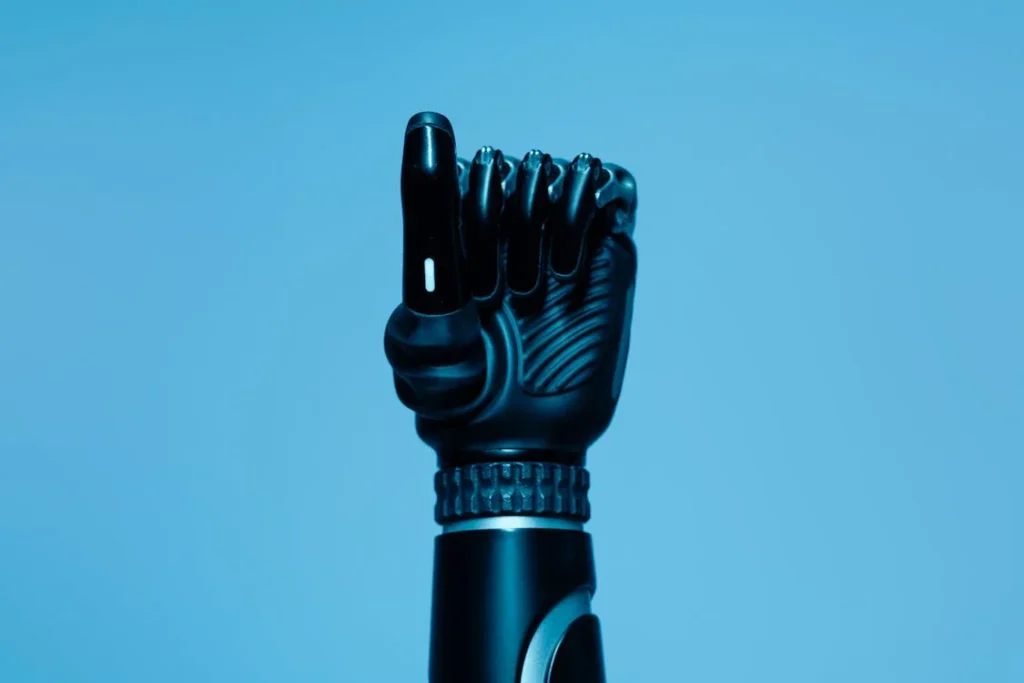
A prosthetic device is an investment in your independence and mobility, and its longevity is directly tied to how well it is maintained. While advanced prosthetics are designed for durability, their intricate components and regular use mean that consistent upkeep is essential.
Strategic maintenance not only prolongs the life of your prosthetic but also ensures it continues to deliver the comfort and functionality you rely on every day.
Preventive care is at the heart of extending the lifespan of your prosthetic. This approach focuses on addressing minor issues before they become significant problems, ensuring the device remains reliable and effective over time.
Regularly inspecting your prosthetic for signs of wear or damage, such as loosened screws, cracks in the socket, or thinning liners, allows you to catch and resolve concerns early.
For bionic prosthetics, preventive care also includes monitoring electronic components for responsiveness and recalibrating sensors as needed.
Early intervention not only protects your prosthetic from further damage but also reduces the likelihood of unexpected failures that could disrupt your routine.
Cleaning your prosthetic is a fundamental part of maintenance, but it goes beyond aesthetics. Dirt, sweat, and oils from your skin can accumulate on the device, particularly in areas like the liner and socket, leading to irritation, odors, or even material degradation.
Establishing a consistent cleaning routine ensures that your prosthetic remains hygienic and functional. Use mild soap and warm water for cleaning, avoiding harsh chemicals that could damage sensitive components.
Dry the prosthetic thoroughly after cleaning, as moisture left behind can contribute to corrosion or compromise electronic parts.
Mechanical components, such as hinges, joints, and suspension systems, are critical to the functionality of your prosthetic. Over time, these parts can experience wear due to repeated use, particularly in high-impact areas like the knee or ankle of a lower-limb prosthetic.
To preserve their precision, regular lubrication may be necessary, but it’s important to use products recommended by the manufacturer.
Avoiding exposure to abrasive materials or excessive force also helps maintain the integrity of these components. Routine checkups with your prosthetist allow for a more detailed evaluation, ensuring mechanical parts remain aligned and functional.
For bionic prosthetics, maintaining the functionality of electronic systems is a top priority. Microprocessors, sensors, and batteries all require specialized care to ensure they perform optimally.
Protecting your prosthetic from environmental hazards, such as moisture, dirt, or extreme temperatures, is crucial for sustaining electronic performance.
Regularly charging and monitoring the battery ensures that your device remains operational when you need it. If you notice delays in response or irregularities in motion, professional recalibration may be necessary to restore peak functionality.
Many advanced prosthetics include software that controls their functionality and adapts the device to your needs. Regular updates to this software often include enhancements that improve efficiency, add new features, or fix bugs.
Working with your prosthetist to stay informed about available updates ensures your device remains compatible with the latest technology. These updates not only enhance the user experience but also prolong the life of your prosthetic by keeping its systems current and efficient.
While daily maintenance addresses immediate needs, professional maintenance provides a comprehensive evaluation of your prosthetic’s condition.
Routine visits to your prosthetist allow for detailed inspections, from assessing the fit and alignment to testing the functionality of advanced components.
During these checkups, your prosthetist can identify issues that may not be visible to you, such as subtle shifts in alignment or early signs of wear in mechanical parts.
By addressing these concerns proactively, professional maintenance ensures your prosthetic remains reliable and performs at its best for the long term.
Extending the life of your prosthetic requires more than isolated efforts—it demands an ongoing commitment to care.
By combining consistent cleaning, preventive inspections, and professional support, you create a maintenance routine that supports the longevity of your device.
This routine should be tailored to your lifestyle, accounting for factors such as activity level, environmental conditions, and the specific demands placed on your prosthetic.
A well-maintained device not only saves you time and money on repairs but also enhances your overall quality of life by ensuring continuous comfort and functionality.
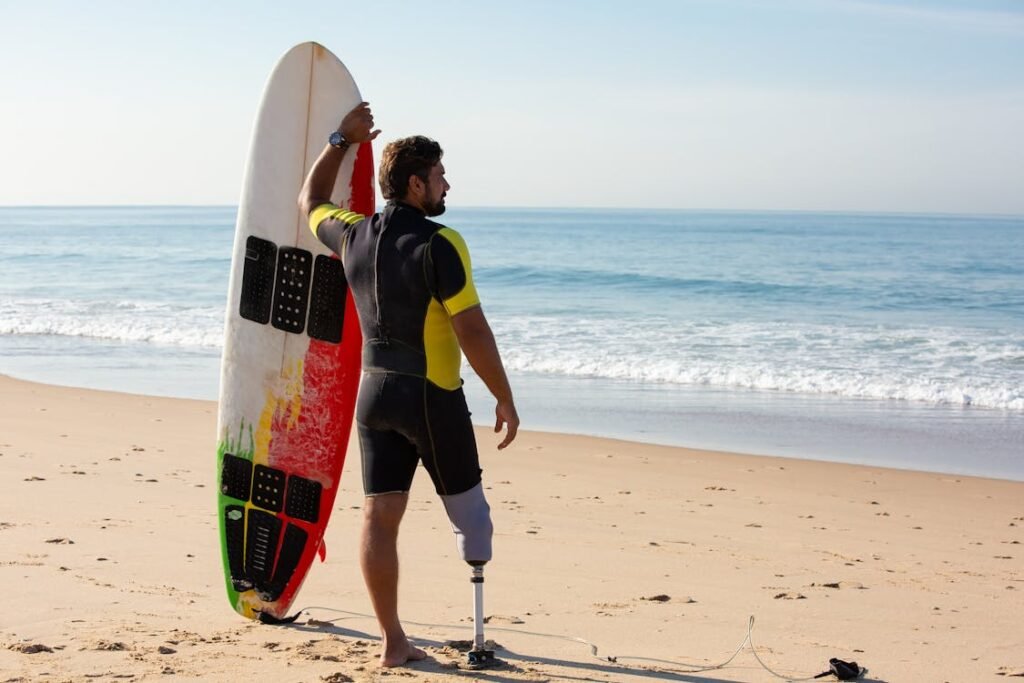
The environment you navigate daily plays a significant role in the wear and performance of your prosthetic. From fluctuating weather conditions to physical terrains, various environmental factors can impact the durability, functionality, and comfort of your device.
Adapting strategically to these challenges not only protects your prosthetic but also ensures it continues to meet your needs in every situation.
Temperature extremes can affect both the physical and electronic components of a prosthetic. In hot weather, the combination of heat and perspiration can compromise the fit of the liner, causing slippage and discomfort.
Prolonged exposure to high temperatures may also weaken certain materials or adhesives used in the prosthetic, potentially leading to wear over time.
Cold temperatures, on the other hand, can reduce the flexibility of some materials, making them feel rigid and less responsive. For bionic prosthetics, battery performance can be affected in colder climates, reducing the duration of operation and limiting reliability.
Adapting to these conditions requires a proactive approach. For example, in hot weather, using moisture-wicking liners and cleaning your prosthetic more frequently can improve comfort and hygiene.
During colder months, insulating covers or proper storage can help maintain the prosthetic’s flexibility and protect its electronic components.
Humidity is a persistent challenge for prosthetic users, particularly in tropical or monsoon-prone regions.
High moisture levels in the air can accelerate the wear of materials, while sweat buildup under the liner can lead to skin irritation or bacterial growth. For prosthetics with electronic systems, humidity increases the risk of damage to circuits and sensors.
To mitigate these effects, maintaining a dry environment for your prosthetic is essential. Regular cleaning, combined with the use of breathable liners, helps to reduce the impact of moisture on both the device and your residual limb.
Storing your prosthetic in a moisture-resistant bag or case when not in use can further protect it from prolonged exposure to humidity.
Dust and debris can infiltrate mechanical components, causing friction and reducing the precision of joints and hinges. For bionic prosthetics, these particles can interfere with sensors or disrupt electronic systems, impacting the overall functionality of the device.
Individuals who frequently encounter dusty or sandy environments—whether due to work, travel, or outdoor activities—should pay extra attention to cleaning and protecting their prosthetic.
Using protective covers specifically designed to shield the device from debris can minimize exposure, while thorough cleaning after exposure ensures that particles don’t accumulate over time.
The type of terrain you traverse daily also affects the performance and longevity of your prosthetic. Uneven surfaces, inclines, and rough paths place additional strain on the device, particularly for lower-limb prosthetics.
Components like shock absorbers, joints, and foot modules must work harder to provide stability and support, increasing wear over time.
To adapt, it’s important to ensure that your prosthetic is equipped for the terrains you encounter most often. For example, if you frequently hike or walk on rough surfaces, a prosthetic with enhanced shock absorption or specialized foot components may be beneficial.
Collaborating with your prosthetist to customize the device for your specific needs ensures that it performs optimally, regardless of the environment.
Water exposure presents a unique challenge for prosthetic users, particularly those who live in rainy climates or participate in activities like swimming.
Unless your prosthetic is specifically designed to be waterproof, even brief contact with water can lead to corrosion in mechanical parts or damage to electronic components.
Preventive measures, such as using waterproof covers during rainy seasons or choosing water-resistant materials for liners, can help mitigate these risks.
For activities involving significant water exposure, discussing waterproof prosthetic options with your prosthetist ensures you have a device that supports your lifestyle while remaining durable.
Adapting to environmental challenges isn’t just about reacting to conditions—it involves a long-term strategy for protecting your prosthetic.
Regular inspections after exposure to harsh environments allow you to catch and address potential issues early. This includes checking for rust, cracks, or wear in high-stress areas.
Proactively maintaining your device after environmental strain ensures that it remains reliable and comfortable over time.
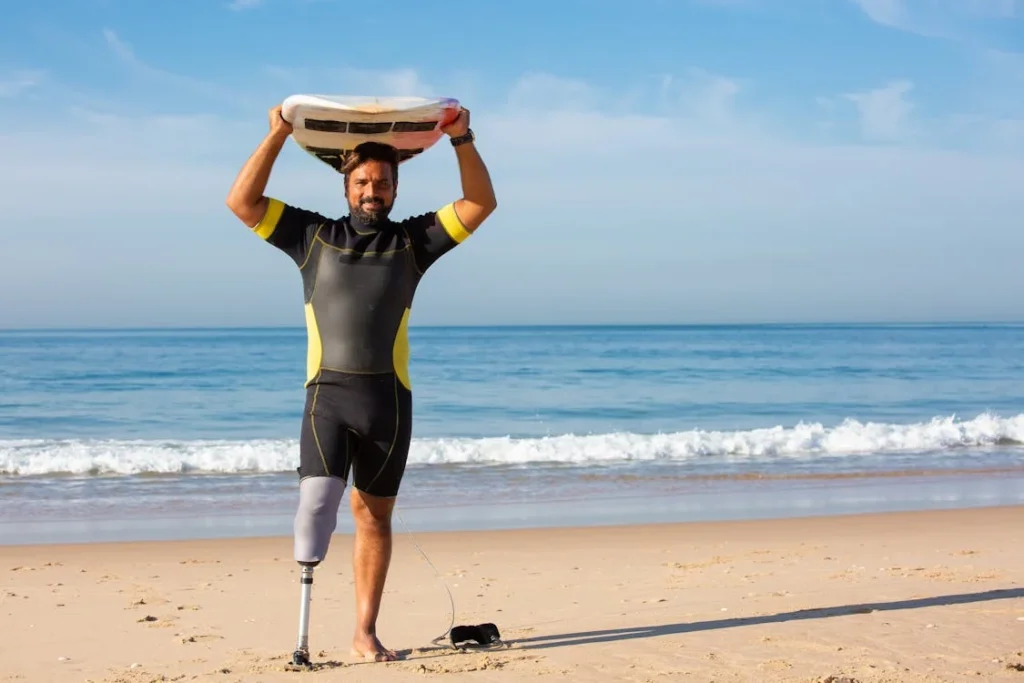
The connection between your prosthetic and your residual limb is one of the most critical aspects of your overall prosthetic experience. This interface directly influences comfort, mobility, and functionality, making it essential to nurture and maintain this bond.
Achieving long-term success requires not only physical adjustments but also a strategic approach to ensuring your residual limb remains healthy and works harmoniously with your prosthetic device.
A snug and secure fit is the foundation of a well-functioning prosthetic. This connection allows for stability, precise control, and seamless movement.
However, maintaining this fit is not always straightforward. Factors such as daily swelling, muscle atrophy, or changes in body weight can alter how your prosthetic feels over time.
Achieving and sustaining an ideal fit requires consistent monitoring of how your prosthetic interacts with your residual limb. Pay attention to whether the socket feels tight, loose, or uneven during different activities.
Minor adjustments, like using prosthetic socks to accommodate small volume changes, can make an immediate difference. However, for more substantial shifts, consulting a prosthetist for socket modifications or re-fittings ensures continued comfort and functionality.
The health of your residual limb’s skin is crucial for maintaining a comfortable connection with your prosthetic. Irritated or damaged skin can lead to pain, infection, and a compromised fit.
Daily skin care practices are essential to prevent these issues and ensure the limb remains resilient.
Cleaning your residual limb thoroughly each day removes sweat, dirt, and bacteria that can accumulate under the liner. Using non-irritating soaps and drying the limb completely prevents moisture-related problems like fungal infections or chafing.
For users with sensitive skin, hypoallergenic liners or barrier creams can provide additional protection without interfering with the prosthetic’s fit.
The forces exerted by your prosthetic on your residual limb during movement can lead to friction and pressure, both of which affect comfort. Identifying areas where pressure points develop or where the liner feels abrasive allows you to address these issues before they escalate.
Custom liners, gel pads, or prosthetic socks can help distribute pressure more evenly, reducing strain on sensitive areas. If specific spots continue to cause discomfort, your prosthetist can adjust the socket design to better accommodate your limb’s contours.
Proactively managing these dynamics ensures a smoother and more stable connection between your limb and prosthetic.
Your residual limb evolves over time due to physical activity, age, or even daily routines. These changes can subtly alter the way your prosthetic fits and feels. Adapting to these shifts is essential for preserving the long-term connection between your body and the device.
Regular checkups with your prosthetist provide an opportunity to assess how your prosthetic fits in light of these changes.
For instance, if your activity levels increase, the socket may need reinforcement or realignment to accommodate added strain. Similarly, as your residual limb’s shape adjusts, updating the liner or socket design ensures continued comfort and support.
Maintaining the connection with your prosthetic isn’t solely about physical aspects—it’s also about emotional confidence. A secure and well-functioning prosthetic fosters trust in its reliability, allowing you to engage fully in daily activities without hesitation.
Conversely, if the connection feels unstable or uncomfortable, it can lead to frustration or a lack of confidence in the device. Addressing these concerns promptly and working closely with your prosthetist to resolve issues reinforces a positive emotional relationship with your prosthetic.
Your prosthetist is your partner in maintaining the connection between your prosthetic and your residual limb. Openly sharing feedback about your experiences, including any discomfort or changes in your limb, ensures that adjustments are timely and tailored to your needs.
For example, if you notice that your prosthetic feels different after extended periods of wear or specific activities, your prosthetist can identify potential causes and recommend solutions.
This collaborative approach creates a dynamic and evolving strategy for maintaining a seamless connection.

Advanced technology has transformed prosthetics, turning them into highly functional and intuitive devices that integrate seamlessly with the user’s body.
These innovations not only improve mobility and ease of use but also enhance long-term functionality by adapting to changing needs and environments.
Understanding how to optimize these technologies ensures that your prosthetic remains a reliable and empowering tool for years to come.
Modern prosthetics often include smart systems that utilize sensors, microprocessors, and algorithms to adapt to the user’s movements.
These systems are designed to respond dynamically to real-time inputs, such as muscle signals, pressure changes, or gait variations. This responsiveness allows for smoother and more natural movements, significantly reducing the strain on the user’s body.
For example, myoelectric prosthetics use sensors to detect electrical signals from muscles, translating them into precise movements of the prosthetic limb.
This technology minimizes the effort required for tasks and enhances overall usability. To maintain these benefits, regular calibration and software updates are essential, ensuring that the device continues to operate efficiently as your body and lifestyle evolve.
One of the greatest advantages of advanced technology is its ability to enhance comfort through adaptive features. Many prosthetics now include mechanisms that adjust automatically to changes in terrain, activity level, or environmental conditions.
These adaptive features reduce the user’s need to compensate manually, improving both comfort and functionality.
For instance, lower-limb prosthetics with microprocessor-controlled knees or ankles can adjust the level of resistance based on the speed of walking or the incline of the terrain.
This prevents awkward or unnatural movements, reducing strain on the residual limb and supporting better posture. By understanding and utilizing these features, you can maximize the comfort and performance of your prosthetic over time.
Bionic prosthetics rely on batteries to power their advanced features, making battery management a crucial aspect of maintaining functionality. Proper care and usage habits ensure that the battery operates at peak capacity and lasts for its full lifespan.
Avoiding overcharging, monitoring the battery’s performance, and replacing it when necessary are all important practices.
Additionally, having a backup plan—such as carrying a spare battery or charging device—ensures uninterrupted use, especially during extended activities or travel. These small yet strategic steps safeguard the reliability of your prosthetic’s technology.
The materials used in advanced prosthetics are engineered for durability, flexibility, and lightweight comfort. Innovations in material science, such as carbon fiber, titanium, and silicone, enhance the prosthetic’s performance while reducing the physical burden on the user.
These materials also improve shock absorption and energy return, particularly in lower-limb prosthetics designed for active users.
Maintaining these materials involves regular cleaning, avoiding exposure to corrosive substances, and promptly addressing signs of wear. By preserving the integrity of the materials, you ensure that your prosthetic continues to perform at its best.
Advanced prosthetics often come equipped with software that governs their functionality. Manufacturers frequently release updates to refine the device’s performance, add new features, or address user feedback.
Staying up to date with these advancements is essential for optimizing your prosthetic’s capabilities.
Many devices also allow for personalization through companion apps or professional adjustments. These settings can fine-tune aspects like grip strength, movement sensitivity, or resistance levels, tailoring the prosthetic to your unique needs.
Collaborating with your prosthetist to explore these options ensures a customized experience that enhances long-term functionality.
Some advanced prosthetics incorporate data analytics to track usage patterns, identify potential issues, and provide insights into performance. This data can be invaluable for both you and your prosthetist in making informed decisions about adjustments or upgrades.
For example, usage data might reveal uneven pressure distribution, indicating the need for alignment changes. Similarly, activity tracking can help optimize settings for specific tasks or activities, such as sports or manual labor.
Leveraging this information ensures that your prosthetic evolves alongside your lifestyle, maintaining its relevance and functionality.
While advanced prosthetic technology offers immense benefits, it’s natural to feel overwhelmed by its complexity. Building confidence in using these features involves education, practice, and support from professionals.
Taking the time to understand how your device works, participating in training sessions, and seeking guidance from your prosthetist can help you feel more at ease with the technology.
This confidence is crucial for embracing the full potential of your prosthetic. When you trust the device and its capabilities, you’re more likely to engage in activities and challenges that enrich your life, ensuring that the technology truly serves as an extension of yourself.
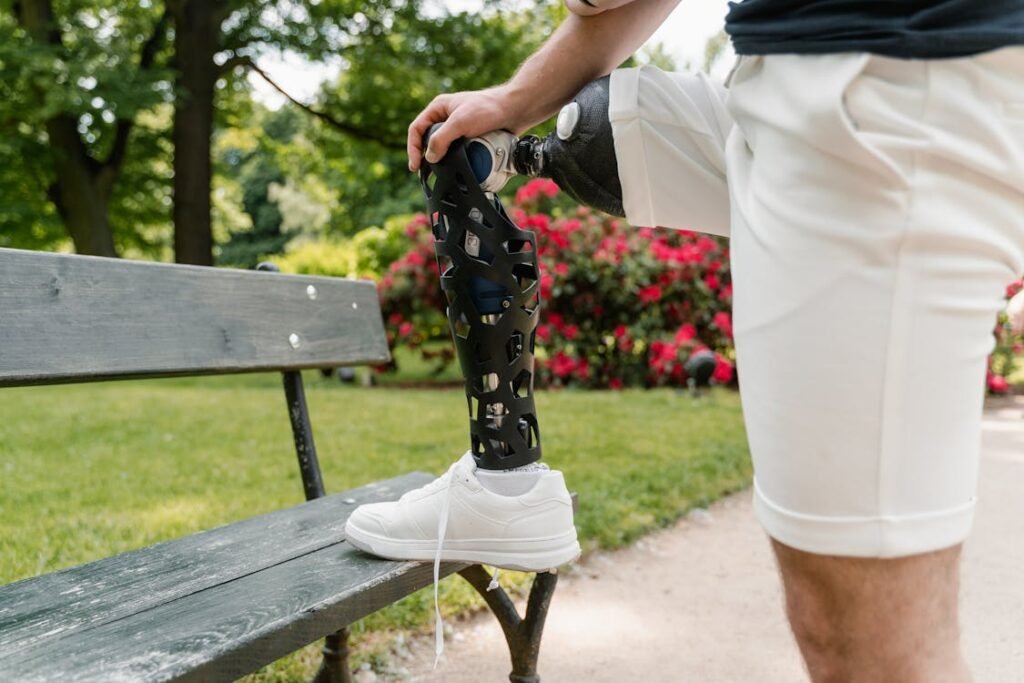
Your prosthetist is more than a healthcare professional—they are a vital partner in your journey toward achieving long-term comfort and functionality with your prosthetic.
This relationship is built on trust, communication, and collaboration, ensuring that your prosthetic continues to meet your evolving needs.
Developing a strong partnership with your prosthetist is essential for navigating the complexities of prosthetic care and maximizing the benefits of your device.
The foundation of any successful partnership is clear and open communication. Sharing detailed feedback about your experiences with your prosthetic allows your prosthetist to understand your unique challenges and aspirations.
For instance, discussing discomfort during specific activities, difficulty in maintaining balance, or issues with fit helps your prosthetist pinpoint areas that require adjustment.
Even minor observations, such as occasional pressure points or changes in how your prosthetic feels after prolonged use, can provide valuable insights for refining your device.
Prosthetists rely on this information to make tailored recommendations, from realigning the socket to upgrading components. Transparent communication ensures that every adjustment or enhancement is directly aligned with your goals, improving both your comfort and mobility.
Every individual’s needs and lifestyle are unique, and your prosthetist’s expertise allows them to customize your prosthetic to suit these specific requirements.
This customization goes beyond the initial fitting, encompassing ongoing modifications as your body, activities, or environment change.
For example, if you decide to take up a new hobby, such as cycling or swimming, your prosthetist can help adapt your prosthetic to accommodate these activities.
This might involve upgrading components, adding specialized attachments, or suggesting advanced features designed for specific movements. Collaborating on these adjustments ensures that your prosthetic evolves with you, supporting both new and existing aspirations.
Scheduled appointments with your prosthetist are not just routine—they are opportunities for proactive care and improvement. During these visits, your prosthetist conducts detailed evaluations to assess the fit, alignment, and functionality of your prosthetic.
These checkups allow for early detection of issues, such as subtle misalignments or wear in mechanical components, which might otherwise go unnoticed. Addressing these concerns before they escalate not only prevents discomfort but also extends the lifespan of your prosthetic.
Additionally, these appointments provide a platform for discussing technological advancements. Your prosthetist can inform you about new materials, features, or software updates that might enhance your device’s performance.
This ensures that your prosthetic remains aligned with the latest innovations, empowering you to take full advantage of available advancements.
Life is dynamic, and your prosthetist is there to help you adapt your prosthetic to changes in your body, activities, or goals.
Whether it’s addressing shifts in your residual limb’s size, preparing for a physically demanding lifestyle, or accommodating changes in mobility needs, your prosthetist plays a critical role in ensuring a smooth transition.
For example, after a significant life event such as weight loss or an increase in physical activity, your prosthetist can reassess the fit and alignment of your prosthetic.
By staying attuned to these changes, they ensure that your device continues to provide the comfort, support, and functionality required for your daily life.
A strong partnership with your prosthetist is rooted in trust, and this trust is earned through their expertise and commitment to your well-being. Your prosthetist is not just a technician—they are a problem solver, educator, and advocate for your mobility and independence.
Taking the time to understand their recommendations, asking questions, and actively participating in decisions about your prosthetic care fosters mutual respect and collaboration.
This trust empowers you to approach challenges with confidence, knowing that your prosthetist is there to provide guidance and solutions tailored to your unique needs.
The relationship with your prosthetist goes beyond technical adjustments—it also encompasses emotional support. Navigating the complexities of prosthetic use can be challenging, and having a compassionate professional by your side makes a significant difference.
Your prosthetist understands the physical and emotional aspects of living with a prosthetic, offering encouragement and reassurance during difficult times.
This holistic approach helps you build a positive outlook and strengthens your connection to the prosthetic as a tool for empowerment rather than limitation.
Ensuring the long-term comfort and functionality of your prosthetic requires a proactive and strategic approach. By focusing on regular maintenance, monitoring changes in your body and environment, and leveraging professional support, you can keep your prosthetic as reliable and effective as the day you received it.
At Robobionics, we are committed to empowering prosthetic users with expert care, innovative solutions, and personalized guidance. Your prosthetic is more than a device—it’s a gateway to independence, confidence, and a fulfilling life.
Ready to optimize your prosthetic for long-term comfort and performance? Contact Robobionics today for expert care and personalized solutions tailored to your needs.

For doctors treating upper-limb loss, the choice between a myoelectric prosthesis and a body-powered device

Every doctor who treats severe limb injury faces one of the hardest choices in medicine.

Cost-effectiveness should feel clear, not scary. As clinicians in India, you make tough choices every

Microprocessor knees often get discussed as premium technology, but hospitals look at them through a
Last updated: November 10, 2022
Thank you for shopping at Robo Bionics.
If, for any reason, You are not completely satisfied with a purchase We invite You to review our policy on refunds and returns.
The following terms are applicable for any products that You purchased with Us.
The words of which the initial letter is capitalized have meanings defined under the following conditions. The following definitions shall have the same meaning regardless of whether they appear in singular or in plural.
For the purposes of this Return and Refund Policy:
Company (referred to as either “the Company”, “Robo Bionics”, “We”, “Us” or “Our” in this Agreement) refers to Bionic Hope Private Limited, Pearl Haven, 1st Floor Kumbharwada, Manickpur Near St. Michael’s Church Vasai Road West, Palghar Maharashtra 401202.
Goods refer to the items offered for sale on the Website.
Orders mean a request by You to purchase Goods from Us.
Service refers to the Services Provided like Online Demo and Live Demo.
Website refers to Robo Bionics, accessible from https://robobionics.in
You means the individual accessing or using the Service, or the company, or other legal entity on behalf of which such individual is accessing or using the Service, as applicable.
You are entitled to cancel Your Service Bookings within 7 days without giving any reason for doing so, before completion of Delivery.
The deadline for cancelling a Service Booking is 7 days from the date on which You received the Confirmation of Service.
In order to exercise Your right of cancellation, You must inform Us of your decision by means of a clear statement. You can inform us of your decision by:
We will reimburse You no later than 7 days from the day on which We receive your request for cancellation, if above criteria is met. We will use the same means of payment as You used for the Service Booking, and You will not incur any fees for such reimbursement.
Please note in case you miss a Service Booking or Re-schedule the same we shall only entertain the request once.
In order for the Goods to be eligible for a return, please make sure that:
The following Goods cannot be returned:
We reserve the right to refuse returns of any merchandise that does not meet the above return conditions in our sole discretion.
Only regular priced Goods may be refunded by 50%. Unfortunately, Goods on sale cannot be refunded. This exclusion may not apply to You if it is not permitted by applicable law.
You are responsible for the cost and risk of returning the Goods to Us. You should send the Goods at the following:
We cannot be held responsible for Goods damaged or lost in return shipment. Therefore, We recommend an insured and trackable courier service. We are unable to issue a refund without actual receipt of the Goods or proof of received return delivery.
If you have any questions about our Returns and Refunds Policy, please contact us:
Last Updated on: 1st Jan 2021
These Terms and Conditions (“Terms”) govern Your access to and use of the website, platforms, applications, products and services (ively, the “Services”) offered by Robo Bionics® (a registered trademark of Bionic Hope Private Limited, also used as a trade name), a company incorporated under the Companies Act, 2013, having its Corporate office at Pearl Heaven Bungalow, 1st Floor, Manickpur, Kumbharwada, Vasai Road (West), Palghar – 401202, Maharashtra, India (“Company”, “We”, “Us” or “Our”). By accessing or using the Services, You (each a “User”) agree to be bound by these Terms and all applicable laws and regulations. If You do not agree with any part of these Terms, You must immediately discontinue use of the Services.
1.1 “Individual Consumer” means a natural person aged eighteen (18) years or above who registers to use Our products or Services following evaluation and prescription by a Rehabilitation Council of India (“RCI”)–registered Prosthetist.
1.2 “Entity Consumer” means a corporate organisation, nonprofit entity, CSR sponsor or other registered organisation that sponsors one or more Individual Consumers to use Our products or Services.
1.3 “Clinic” means an RCI-registered Prosthetics and Orthotics centre or Prosthetist that purchases products and Services from Us for fitment to Individual Consumers.
1.4 “Platform” means RehabConnect™, Our online marketplace by which Individual or Entity Consumers connect with Clinics in their chosen locations.
1.5 “Products” means Grippy® Bionic Hand, Grippy® Mech, BrawnBand™, WeightBand™, consumables, accessories and related hardware.
1.6 “Apps” means Our clinician-facing and end-user software applications supporting Product use and data collection.
1.7 “Impact Dashboard™” means the analytics interface provided to CSR, NGO, corporate and hospital sponsors.
1.8 “Services” includes all Products, Apps, the Platform and the Impact Dashboard.
2.1 Individual Consumers must be at least eighteen (18) years old and undergo evaluation and prescription by an RCI-registered Prosthetist prior to purchase or use of any Products or Services.
2.2 Entity Consumers must be duly registered under the laws of India and may sponsor one or more Individual Consumers.
2.3 Clinics must maintain valid RCI registration and comply with all applicable clinical and professional standards.
3.1 Robo Bionics acts solely as an intermediary connecting Users with Clinics via the Platform. We do not endorse or guarantee the quality, legality or outcomes of services rendered by any Clinic. Each Clinic is solely responsible for its professional services and compliance with applicable laws and regulations.
4.1 All content, trademarks, logos, designs and software on Our website, Apps and Platform are the exclusive property of Bionic Hope Private Limited or its licensors.
4.2 Subject to these Terms, We grant You a limited, non-exclusive, non-transferable, revocable license to use the Services for personal, non-commercial purposes.
4.3 You may not reproduce, modify, distribute, decompile, reverse engineer or create derivative works of any portion of the Services without Our prior written consent.
5.1 Limited Warranty. We warrant that Products will be free from workmanship defects under normal use as follows:
(a) Grippy™ Bionic Hand, BrawnBand® and WeightBand®: one (1) year from date of purchase, covering manufacturing defects only.
(b) Chargers and batteries: six (6) months from date of purchase.
(c) Grippy Mech™: three (3) months from date of purchase.
(d) Consumables (e.g., gloves, carry bags): no warranty.
5.2 Custom Sockets. Sockets fabricated by Clinics are covered only by the Clinic’s optional warranty and subject to physiological changes (e.g., stump volume, muscle sensitivity).
5.3 Exclusions. Warranty does not apply to damage caused by misuse, user negligence, unauthorised repairs, Acts of God, or failure to follow the Instruction Manual.
5.4 Claims. To claim warranty, You must register the Product online, provide proof of purchase, and follow the procedures set out in the Warranty Card.
5.5 Disclaimer. To the maximum extent permitted by law, all other warranties, express or implied, including merchantability and fitness for a particular purpose, are disclaimed.
6.1 We collect personal contact details, physiological evaluation data, body measurements, sensor calibration values, device usage statistics and warranty information (“User Data”).
6.2 User Data is stored on secure servers of our third-party service providers and transmitted via encrypted APIs.
6.3 By using the Services, You consent to collection, storage, processing and transfer of User Data within Our internal ecosystem and to third-party service providers for analytics, R&D and support.
6.4 We implement reasonable security measures and comply with the Information Technology Act, 2000, and Information Technology (Reasonable Security Practices and Procedures and Sensitive Personal Data or Information) Rules, 2011.
6.5 A separate Privacy Policy sets out detailed information on data processing, user rights, grievance redressal and cross-border transfers, which forms part of these Terms.
7.1 Pursuant to the Information Technology Rules, 2021, We have given the Charge of Grievance Officer to our QC Head:
- Address: Grievance Officer
- Email: support@robobionics.in
- Phone: +91-8668372127
7.2 All support tickets and grievances must be submitted exclusively via the Robo Bionics Customer Support portal at https://robobionics.freshdesk.com/.
7.3 We will acknowledge receipt of your ticket within twenty-four (24) working hours and endeavour to resolve or provide a substantive response within seventy-two (72) working hours, excluding weekends and public holidays.
8.1 Pricing. Product and Service pricing is as per quotations or purchase orders agreed in writing.
8.2 Payment. We offer (a) 100% advance payment with possible incentives or (b) stage-wise payment plans without incentives.
8.3 Refunds. No refunds, except pro-rata adjustment where an Individual Consumer is medically unfit to proceed or elects to withdraw mid-stage, in which case unused stage fees apply.
9.1 Users must follow instructions provided by RCI-registered professionals and the User Manual.
9.2 Users and Entity Consumers shall indemnify and hold Us harmless from all liabilities, claims, damages and expenses arising from misuse of the Products, failure to follow professional guidance, or violation of these Terms.
10.1 To the extent permitted by law, Our total liability for any claim arising out of or in connection with these Terms or the Services shall not exceed the aggregate amount paid by You to Us in the twelve (12) months preceding the claim.
10.2 We shall not be liable for any indirect, incidental, consequential or punitive damages, including loss of profit, data or goodwill.
11.1 Our Products are classified as “Rehabilitation Aids,” not medical devices for diagnostic purposes.
11.2 Manufactured under ISO 13485:2016 quality management and tested for electrical safety under IEC 60601-1 and IEC 60601-1-2.
11.3 Products shall only be used under prescription and supervision of RCI-registered Prosthetists, Physiotherapists or Occupational Therapists.
We do not host third-party content or hardware. Any third-party services integrated with Our Apps are subject to their own terms and privacy policies.
13.1 All intellectual property rights in the Services and User Data remain with Us or our licensors.
13.2 Users grant Us a perpetual, irrevocable, royalty-free licence to use anonymised usage data for analytics, product improvement and marketing.
14.1 We may amend these Terms at any time. Material changes shall be notified to registered Users at least thirty (30) days prior to the effective date, via email and website notice.
14.2 Continued use of the Services after the effective date constitutes acceptance of the revised Terms.
Neither party shall be liable for delay or failure to perform any obligation under these Terms due to causes beyond its reasonable control, including Acts of God, pandemics, strikes, war, terrorism or government regulations.
16.1 All disputes shall be referred to and finally resolved by arbitration under the Arbitration and Conciliation Act, 1996.
16.2 A sole arbitrator shall be appointed by Bionic Hope Private Limited or, failing agreement within thirty (30) days, by the Mumbai Centre for International Arbitration.
16.3 Seat of arbitration: Mumbai, India.
16.4 Governing law: Laws of India.
16.5 Courts at Mumbai have exclusive jurisdiction over any proceedings to enforce an arbitral award.
17.1 Severability. If any provision is held invalid or unenforceable, the remainder shall remain in full force.
17.2 Waiver. No waiver of any breach shall constitute a waiver of any subsequent breach of the same or any other provision.
17.3 Assignment. You may not assign your rights or obligations without Our prior written consent.
By accessing or using the Products and/or Services of Bionic Hope Private Limited, You acknowledge that You have read, understood and agree to be bound by these Terms and Conditions.